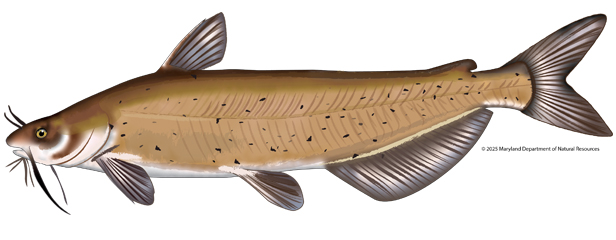| Channel Catfish |
 |
Channel Catfish |
| Ictalurus punctatus |
(A.K.A. Forked Tail, Spotted Cat, River Cats)
|
Key Distinguishing Markings:
- Channel catfish are members of the bullhead catfish family, Ictaluridae, and are a freshwater species that are commonly found in estuarine waters.
- Channel catfish are long slender fish with barbels on the chin that look like long black whiskers. There are four pairs of barbels around the mouth, two on the chin, one at the angle of the mouth, and one behind the nostril.
- Channel catfish lack scales and possess an adipose fin, as well as a single, often serrated spine in the dorsal and pectoral fins.
- The channel catfish is generally gray to greenish-gray on the upper part of its slender body, silver to white on its lower half and belly and has a deeply forked tail. Small adults and juveniles have black or dusky spots on their body.
- Channel catfish typically possess an anal fin with 24 to 30 rays.
View the Channel Catfish Gallery
|
Distribution:
- The native range of channel catfish extends from southern Canada, through the Great Lakes and central United States drainage system, to Mexico including all the Gulf states and some of the Atlantic coast.
- However, due to extensive introductions, their current range includes all of the Pacific and Atlantic drainage systems in the 48 continental states.
- As a non-native species, channel catfish have become very successful in tidal and non tidal waters across the state.
|
Size:
- One of the largest catfish species found in North America and can weigh near 60 pounds.
- Maryland state tidal water record is 29 pounds 10 oz. It was caught in the tidal Potomac River near Mattawoman Creek.
- The freshwater record is 27.92 pounds and was caught in the upper Potomac River.
|
Habitat:
- Channel catfish live mainly in fresh water and can be found in the freshwater portion of the Chesapeake Bay and its tributaries.
- Channel catfish prefer deep pools around logs, rocks and other structure where they can hide.
|
Spawning:
- Channel catfish spawn in late spring when water temperatures reach 75oF and lay approximately 2,000 to 21,000 eggs in turbid tributaries.
- It is not uncommon for the male fish to spawn with more than one female.
- These fish select nest sites in dark depressions, cavities, or undercut stream banks, or inside crevices, hollow logs, or man-made containers
- Spawning success is dependent on available cover.
- Upon hatching, catfish fry sometimes aggregate in tight schools after leaving the nest until suitable cover is found.
- Fingerlings school together during daylight hours and disperse and feed at night.
|
Fishing Tips:
- Channel catfish are very good to eat.
- Fresh baits such as peeler or soft crab, shrimp, squid, chicken liver, processed catfish bait, hot dogs and cut fish are good baits for catching channel catfish.
- Popular methods for fishing include bait casting and bottom fishing.
- For current recreational size and creel limits, see Maryland's updated regulation page.
|
Fun Fact:
- The sportfishing world record is a specimen from South Carolina that weighed 58 pounds.
|
| Family: Ictaluridae (North American freshwater catfishes) |
| Order: Siluriformes (catfish) |
| Class: Actinopterygii (ray-finned fishes) |
For more information on channel catfish and their management, please contact Mary Groves.
Illustration by Kevin Ensor,
Maryland Department of Natural Resources,
Fishing and Boating Services
|
